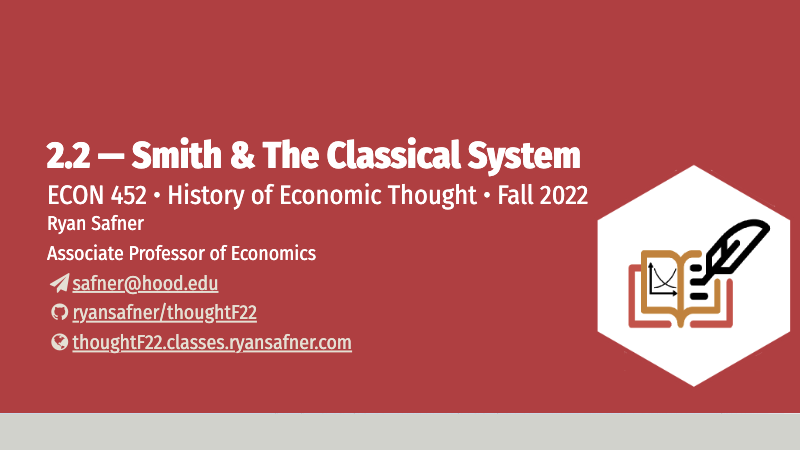2.2 — Adam Smith & The Classical System — Class Content
Overview
Today we continue talking about Adam Smith with an overview of the Classical School of Economics — what generally united them. We also explore Smith and the Classicals’ opposition to mercantilism and Smith’s account of how Europe escaped feudalism.
Readings
Required Readings:
- Adam Smith’s Wealth of Nations: Book IV excerpts in Reader (pp.165-179)
If You Hadn’t Yet:
- Ch.4 “Adam Smith” in Landreth & Colander
- Ch.2 “Adam Smith” in Blaug
Though he is admittedly long-winded and lapses between theoretical statements, historical examples, and analogies or current events from the 18th century, Adam Smith is quite easy and entertaining to read. Any educated person should read Smith, and, if you are interested in economics, you should read as much Smith as you can get your hands on. Everything is there (in some form).
Today we will focus primarily on understanding the system of the Classical Economics (so a bit of foreshadowing), as well as Smith’s refutation of mercantilism and physiocracy. As such, in addition to Smith, I will be quoting from Hume and Bastiat regarding their views on mercantilism (see recommended readings below). The quotes from Hume we have already seen.
The reading for Smith comes primarily from Book IV: Of the Systems of Political Oeconomy. These sections are in your Reader (p.165-179). I will also be quoting form Book III when describing the emergence of commercial society out of feudal society. You can find all of The Wealth of Nations online for free here:
Next class we will dive into more of Smith’s analytical insights and the analysis of markets, prices, and economic growth. See the associated readings from WON for next class.
Recommended Readings:
Weingast discusses Adam Smith’s Book III on the economic history of Europe in the context of his views on economic development:
Below are the readings from Bastiat that I quote. I also make everyone in ECON 306 read (or at least I discuss) Bastiat’s broken window parable in “What is Seen and Not Seen”
- Bastiat (1845) “The Candlemakers Petition”
- Bastiat (1850) “The Balance of Trade”
- Bastiat, 1848 “What is Seen and Not Seen”, (Section 1)
As I mentioned in class, you might find How the Dismal Science Got its Name insightful and surprising. It is a 6 part series of blog posts based on research by David Levy & Sandra Peart. - Part I - Part II - Part III - Part IV - Part V - Part VI
The following Wikipedia entries can also provide more background on these writers and their famous works:
Questions to Help Your Reading
Book III
- How did Europe escape feudalism and emerge a “commercial society”?
Book IV
- What does Smith say about the goal of mercantilism?
- What does Smith say is the goal of all economic activity?
- What does Smith say about the “balance of trade” doctrine?
- What does Smith think of Quesnay and the physiocrats?
- What is the “obvious and simple system of natural liberty?” What duties does Smith believe the government has? ## Slides
Below, you can find the slides in two formats. Clicking the image will bring you to the html version of the slides in a new tab. The lower button will allow you to download a PDF version of the slides.
You can type h to see a special list of viewing options, and type o for an outline view of all the slides.
I suggest printing the slides beforehand and using them to take additional notes in class (not everything is in the slides)!
Assignments
Participation/Discussion Board Posts Due 8 PM Fri Sep 23
This week’s graded discussion is worth 5 points, and can be a combination of discussion in class, and/or posts on the Blackboard Discussion Board by 8 PM this Friday September 23.
Tournament Votes
The first round of the Pre-Classical division of the “Most Interesting Economist in History” tournament is live. Please post your votes in the discussion board.
